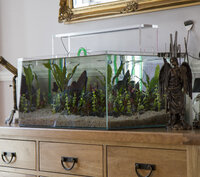Danny
Member
- Joined
- 29 Jul 2012
- Messages
- 863
Anytime someone asks when the co2 should come on either on forums or facebook etc the answer is pretty much generic at 2hrs before lights on, everything you read about it in Google also says the same.
Being totally new I followed that blindly as I'm sure everyone does, the thought of the affect of natural light didn't even cross my mind.
However, even the smallest bit of natural light will have an affect as I've noticed.
I would sit and look at the plants reaching over towards the natural light without even a second thought of having the co2 on as my lights were not on, then once the lights came on later in the day the plants would correct themselves and straighten up towards the light.
After a lot of thinking and confusion about algae issues I came to the conclusion that in fact although I thought my co2 distribution was fine I was I was under supplying the tank by 6hrs based on the affect of the natural light.
My lights come on at 3pm, the co2 was at 1pm the standard 2hrs before lights on. The natural light takes affect on the tank anywhere from 8am on some days and the plants will start reaching towards it.
Why is the default answer about when the co2 should come on 2hrs before lights on? I followed it blindly and I am sure caused myself massive issues due to under supplying the tank.
I wonder how many people with algae issues are also experiencing the same because of also blindly following the 2hr rule, I did see a couple of days ago a post by Clive which mentioned the same and confirmed my thoughts which helped me decide to adjust my co2 on time away from the standard 2hrs before lights on.
Does this make any sense to anyone lol
Being totally new I followed that blindly as I'm sure everyone does, the thought of the affect of natural light didn't even cross my mind.
However, even the smallest bit of natural light will have an affect as I've noticed.
I would sit and look at the plants reaching over towards the natural light without even a second thought of having the co2 on as my lights were not on, then once the lights came on later in the day the plants would correct themselves and straighten up towards the light.
After a lot of thinking and confusion about algae issues I came to the conclusion that in fact although I thought my co2 distribution was fine I was I was under supplying the tank by 6hrs based on the affect of the natural light.
My lights come on at 3pm, the co2 was at 1pm the standard 2hrs before lights on. The natural light takes affect on the tank anywhere from 8am on some days and the plants will start reaching towards it.
Why is the default answer about when the co2 should come on 2hrs before lights on? I followed it blindly and I am sure caused myself massive issues due to under supplying the tank.
I wonder how many people with algae issues are also experiencing the same because of also blindly following the 2hr rule, I did see a couple of days ago a post by Clive which mentioned the same and confirmed my thoughts which helped me decide to adjust my co2 on time away from the standard 2hrs before lights on.
Does this make any sense to anyone lol




